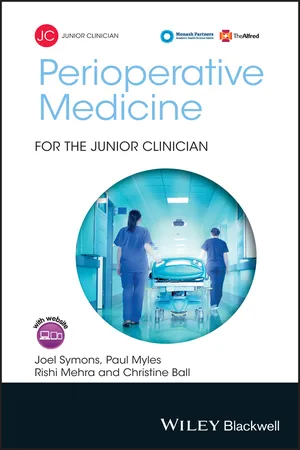
Perioperative Medicine for the Junior Clinician
- English
- ePUB (mobile friendly)
- Available on iOS & Android
Perioperative Medicine for the Junior Clinician
About this book
Perioperative Medicine for the Junior Clinician is the first easy-to-read resource, featuring a digital component, on how to manage a diverse range of patients in the perioperative period, providing up-to-date practical knowledge and advice from a broad range of medical specialists caring for surgical patients.
Perioperative Medicine for the Junior Clinician provides a guide to perioperative care, covering principles and practices of care; risk assessment; laboratory investigations; medication management; specific medical conditions and complications; postoperative care and pain management. It also features bite-size videos explaining the key concepts, as well as case studies, investigations and quizzes.
Ideal for final year medical students and junior clinicians, this digital and print resource will be an invaluable tool when working in this multidisciplinary, team-based specialty.
Perioperative Medicine for the Junior Clinician:
- Is based on a sell-out course run at the Alfred Hospital and Monash University in Melbourne, Australia
- Is a practical resource available in a flexible and portable content
- Features bite-size videos which further explain concepts in the written text, and clinically relevant case studies, all found on the companion website
- Is structured around guidelines and protocols
The video materials, case studies, self-assessment quizzes and fully explained answers can be viewed on the companion website at www.wiley.com/go/perioperativemed
Frequently asked questions
- Essential is ideal for learners and professionals who enjoy exploring a wide range of subjects. Access the Essential Library with 800,000+ trusted titles and best-sellers across business, personal growth, and the humanities. Includes unlimited reading time and Standard Read Aloud voice.
- Complete: Perfect for advanced learners and researchers needing full, unrestricted access. Unlock 1.4M+ books across hundreds of subjects, including academic and specialized titles. The Complete Plan also includes advanced features like Premium Read Aloud and Research Assistant.
Please note we cannot support devices running on iOS 13 and Android 7 or earlier. Learn more about using the app.
Information
Part I
Introduction
1
The role of the perioperative medicine physician
The scope of perioperative medicine
Table of contents
- Cover
- Title page
- Table of Contents
- Foreword
- Preface
- Acknowledgements
- About the companion website
- Part I: Introduction
- Part II: Preoperative risk assessment
- Part III: Perioperative investigations
- Part IV: Specific medication management and prophylaxis
- Part V: Perioperative management of organ dysfunction and specific population groups
- Part VI: Early postoperative care
- Part VII: Pain management
- Index
- End User License Agreement